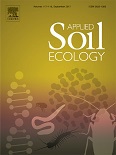Contribution of anecic and epigeic earthworms to biological control of Fusarium graminearum in wheat straw
Dublin Core
Título
Tema
Abstract
Earthworms have proved to contribute to plant health indirectly, by improvement of soil physical and chemical properties, as well as directly, through suppression of plant pathogens. Fusarium Head Blight, caused primarily by Fusarium graminearum, is one of the most important cereal diseases, with severe detrimental effects on yield and grain quality worldwide, and significant effect on grain safety due to the accumulation of mycotoxins produced by the fungus. Earthworms could reduce the residue-borne inoculum density of F. graminearum through different mechanisms, including direct competition by residue consumption, growth inhibition caused by the earthworm coelomic fluid, mechanical disruption of fungal hyphae, and burying crop residue which reduce the
chances for the fungus to release spores for head infection. Thus, the aim of this study was to assess the effects of anecic and epigeic earthworms on wheat straw and on F. graminearum inoculum. For this, PVC cylinders (microcosms 14.5 cm diameter, 30 cm height) were filled with moist soil mix, wheat straw was evenly distributed on the soil surface (inoculated with Fusarium, soil microorganisms or sterile) and three earthworm species (Aporrectodea longa, Lumbricus rubellus or Lumbricus terrestris) were tested. Since the response of earthworms may
change according to conditions of soil moisture and food availability, two different experiments were arranged. The first Experiment represented a sub-optimal situation for earthworms regarding soil moisture and feeding conditions, which was obtained by scarce watering of the microcosms with a consequent decrease in soil water content during incubation, and by not adding cow manure as supplementary food source. In the second experiment, soil was enriched with cow manure as feed for the earthworms and soil moisture was maintained
above 25%. Results from qPCR analysis revealed that F. graminearum inoculum on straw was reduced to undetectable
amounts by L. rubellus and A. longa when the feeding conditions were limited, while no significant differences compared with the control without earthworms were found when earthworms had high food availability (α = 0.05). Straw coverage on soil surface was reduced by L. rubellus (epigeic) in both experiments (p< 0.0001), while A. longa (anecic) just did so under optimal conditions. L. terrestris (anecic), only tested under optimal conditions, reduced soil cover significantly more than the other two species (p < 0.0001). Negative effect
of this fungus was not observed on the studied earthworms. Both anecic and epigeic earthworms tested showed potential to contribute to biological control of F. graminearum in wheat straw. This control may occur by reducing straw on surface, reducing the pathogen inoculum on straw, or both, depending on the environmental conditions and their response according to their ecological group and species. The possibilities to optimize earthworm capacity for biological control of fungal diseases in practical agriculture, under changing weather and organic matter supply conditions, are discussed.
Autor
Fuente
Editor
Fecha
Derechos
(Por favor lea este aviso antes de abrir los documentos u objetos)
La legislación uruguaya protege el derecho de autor sobre toda creación literaria, científica o artística, tanto en lo que tiene que ver con sus derechos morales, como en lo referente a los derechos patrimoniales con sujeción a lo establecido por el derecho común y las siguientes leyes (LEY 9.739 DE 17 DE DICIEMBRE DE 1937 SOBRE PROPIEDAD LITERARIA Y ARTISTICA CON LAS MODIFICACIONES INTRODUCIDAS POR LA LEY DE DERECHO DE AUTOR Y DERECHOS CONEXOS No. 17.616 DE 10 DE ENERO DE 2003, LEY 17.805 DE 26 DE AGOSTO DE 2004, LEY 18.046 DE 24 DE OCTUBRE DE 2006 LEY 18.046 DE 24 DE OCTUBRE DE 2006)
ADVERTENCIA - La consulta de este documento queda condicionada a la aceptación de las siguientes condiciones de uso: Este documento es únicamente para usos privados enmarcados en actividades de investigación y docencia. No se autoriza su reproducción con fines de lucro. Esta reserva de derechos afecta tanto los datos del documento como a sus contenidos. En la utilización o cita de partes debe indicarse el nombre de la persona autora.
Formato
Idioma
Tipo
Identificador
Document Item Type Metadata
Original Format
- Fecha de agregación
- August 27, 2021
- Colección
- Bibliografía Nacional Química
- Tipo de Elemento
- Document
- Etiquetas
- Control biológico, Enfermedades de las plantas, Fusarium Graminearum, Lombrices de tierra, Plantas
- Citación
- Jorge Escudero, Gabriela, “Contribution of anecic and epigeic earthworms to biological control of Fusarium graminearum in wheat straw,” RIQUIM - Repositorio Institucional de la Facultad de Química - UdelaR, accessed July 26, 2024, https://riquim.fq.edu.uy/items/show/6326.
- Archivos

